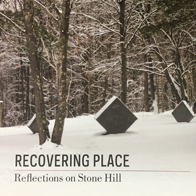Keith Moxey is Barbara Novak Professor of Art History at Barnard College/Columbia University. An art historian who is also interested in visual studies, he contributes to debates relating to the theory and practice of the study of the image in all its forms.

July 4–October 10, 2016
stone shards
Stone shards
Carbonate
Collected on Stone Hill, winter 2016
TRANSCRIPT:
Stone Hill is part of the Taconic Range stretching from southern Vermont into northern Massachusetts. About 450 million years ago, continental drift transformed sedimented layers of mud and rock from a seabed into mountains composed of the schist you can hold in your hand. But is that all this rock has to tell us? These shards were taken from a massive boulder that lies not a quarter of a mile from these galleries. What gigantic force was responsible for its movement? Ice, once more than a mile thick, covered the place on which you now stand. The house-sized boulder to which these pieces belonged was deposited here when the ice melted. The boulder’s presence on Stone Hill, therefore, may date from the last ice age, which took place about 20,000 years ago.
The timeline I have described is impressive and informative as far as it goes. But is that all we mean by place—the place known as Stone Hill? Is history the only form of time contained in these rocks? The boulder appears to us as a kind of ruin, a vestige of another time whose nature remains hidden to us in tales about ancient mountain building and ice ages. Romantic as that story might be, we intuit that there may be another side to this tale. If layers of rock suggest a kind of writing, our eyes nevertheless turn away frustrated by an awareness of their illegibility. Rocks speak to us in languages we cannot decipher and suggest forces too great and too inscrutable for us to grasp. The encounter of two different forms of space and time—natural and human, then and now—is born from the cataclysmic drama that we now casually refer to as Stone Hill.
Recovering Place: Reflecting on Stone Hill
By Mark C. Taylor
An illustrated book chronicling the land art and sculptures created by Mark C. Taylor at his home in the Berkshire hills, echoing themes found in the exhibition. Supported in part by Herbert A. Allen, Jr. and the Clark Art Institute and published by Columbia University Press. Call the Museum Store at 413 458 0520 to order.

.jpg)
